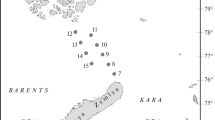Abstract
From 18th December, 1968 to 5th January, 1970, zooplankton samples were taken in darkness and using artificial light in selected areas of the Dar es Salaam coast (Tanzania, S. E. Africa). Surface sea temperature was measured on most occasions, salinity for the first 7 months only. The neritic waters of Dar es Salaam experience a warm period during January to March and a cool period during July to September. The annual salinity cycle is not known. Thirtysix “dark” and 17 “light” zooplankton samples were analysed; where possible, organisms were identified to species, others to generic or higher taxonomic level. The principal taxa and their mean percentage proportions (figures in parentheses) in the “dark” samples were: Calanoida (49. 1), Larvacea (11. 9), Corycaeus spp. (6.4), Cypridina sinuosa (5.6), Oithona spp. (4.8), caridean larvae (4.0), Sagitta spp. (3.8), Euterpina (2.1), Lucifer (1.2), Oncea (1.2), calyptopis larvae (1.0), Hydromedusae (1.0), Euconchoecia chierchiae (1.0), Creseis acicula (1.0), brachyuran zoeae (0.8), Ctenophora (0.5), Mysidacea (0.5), fish eggs (0.5), postlarval bivalves (0.5), postlarval gastropods (0.5), Cumacea (0.1), Gammaridea (0.1) and Hyperiidea (0.1). Evadne tergestina and Thalia democratica abound in waters at certain times of the year only and then virtually disappear. The remaining groups were numerically unimportant most of the time. Almost every major group showed an annual cycle of abundance; greater numbers were recorded either for the entire or part of the period February to August, compared to the period September to November. From the end of January to early August, 1969, the average numbers per haul of total zooplankton were about three times greater than for the period mid-August to mid-November. During February-March and July-August, several oceanic indicators were observed together in the neritic waters. Artificial light induced the following changes in night zooplankton: Mysidacea, Leptochela sp., Hyperiidea, Cypridina sinuosa, brachyuran megalopae and fish larvae were attracted towards artificial light and aggregated densely under the lamp; Calanoida, Corycaeus spp., Macrosetella, Microsetella and Euterpina avoided regions of strong illumination and aggregated in dim-lit areas; Lucifer, Creseis acicula and postlarval gastropods were more abundant in dim-lit samples compared to “dark” hauls; caridean larvae, brachyuran zoeae and larvaceans were less abundant in high-intensity “light” samples compared to “dark” hauls on the same nights.
Similar content being viewed by others
Literature Cited
Aikawa, H.: Further notes on brachyuran larvae. Rec. oceanogr. Wks Japan 9, 87–162 (1937)
Currie, R.I.: The Indian ocean standard net. Deep Sea Res. 10, 27–32 (1963)
— and P. Foxton: A new quantitative net. J. mar. biol. Ass. U. K. 36, 17–25 (1957)
Dales, R.P.: Pelagic polychaetes from waters off the coasts of Kenya and Tanganyika. Ann. Mag. nat. Hist. 13, 503–505 (1963)
Delsman, H.C.: Fish eggs and larvae from the Java Sea. Treubia 8, 218–239 (1926)
Gurney, R.: Larvae of decapod Crustacea, 429 pp. London: Ray Society 1942
Harvey, E.N.: Bioluminscence, 649 pp. London: Academic Press 1952
Harvey, H.W.: The chemistry and fertility of sea waters, 224 pp. London: Cambridge University Press 1963
John, M.A.: Pelagic fish eggs and larvae of the Madras coast. J. zool. Soc. India 3, 41–69 (1951)
Kasturirangan, L.R.: A key for the identification of the more common planktonic copepods of Indian coastal waters, 65 pp. India: Council of Scientific and Industrial Research 1963
Lebour, M.V.: Notes on some larval decapods (Crustacea) from Bermuda. Proc. zool. Soc. Lond. 120, 119–143 (1959)
Newell, B.S.: The hydrography of the British East African coastal waters. II. Fishery Publs colon. Off. 12, 1–18 (1959)
Okera, W.: The food of two species of sardines-Sardinella gibbosa (Bleeker) and S. albella (Valenciennes) in East African waters. In: Symposium on the Indian Ocean and Adjacent Seas, India, 1971a
Okera, W.: Plankton analysis relative to the feeding habits of Sardinella in East African waters. Ph.D. thesis, University of Dar es Salaam, 1971b
Wickstead, J.H.: Estimates of total zooplankton in the Zanzibar area of the Indian Ocean with a comparison of the results with two different nets. Proc. zool. Soc. Lond. 141, 577–608 (1963a)
—: The Cladocera of the Zanzibar area of the Indian Ocean, with a note on the comparative catches of two plankton nets. E. Afr. agric. For. J. 29, 164–172 (1963b)
—: An introduction to the study of tropical plankton, 200 pp. London: Hutchinson 1965
Author information
Authors and Affiliations
Additional information
Communicated by J.H.S. Blaxter, Oban
This work was performed at the Department of Zoology, University of Dar es Salaam, Tanzania, S.E. Africa.
Rights and permissions
About this article
Cite this article
Okera, W. The zooplankton of the inshore waters of Dar es Salaam (Tanzania, S. E. Africa) with observations on reactions to artificial light. Mar. Biol. 26, 13–25 (1974). https://doi.org/10.1007/BF00389082
Accepted:
Published:
Issue Date:
DOI: https://doi.org/10.1007/BF00389082




